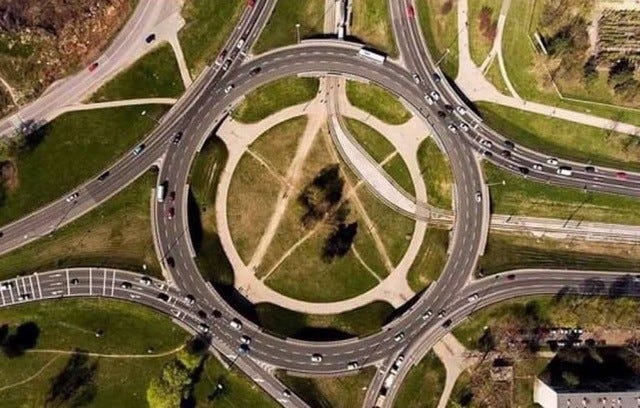In one recent late night scroll—burning time I am told I should be doing other things—I ran across a reddit group documenting “desire paths,” or worn paths in grass or dirt that run at an angle to existing pavement or sidewalks. The name comes from how desire, or whim, or need can lead us to go a different direction than we are supposed to. How together like deer or cows or elephants relief carving the grass with hooves we can find ourselves stepping out on our own and finding kindred spirits along the way.
Desire paths are often discussed because they reveal insufficiency or inefficiency in the built environment where we live. These are unsanctioned shortcuts and paths of least resistance and—impishly—sometimes deviation for deviation’s sake. Many are faster than paved options. A few are just explorations. The author Robert Macfarlane calls them “free-will ways.” Playwright J.M. Barrie went with “paths that have made themselves.”
They can indicate the yearning of those wishing to walk, a way to voice individuality with our bodies, a kind of civil disobedience to crowd control. For Andrew Furman, an architecture professor who has spent years looking at desire paths, they tell us something about “the endless human desire to have choice. The importance of not having someone prescribe your path.” In a heavily constructed city, there are “rules as to how public and public-private spaces are used,” he says. These foot-made paths are where “an individual can really write their own story.”
Sometimes these paths become themselves part of the built environment, spawning secondary spurs. According to some urban planning experts, Broadway was New York City’s earliest desire path, following as it does the Native American-made Wickquasgeck Path, thought to have been the shortest route between pre-colonial settlements in Manhattan avoiding swamps and hills. Broadway is the only remaining desire path, according to some scholars, that hasn’t been wiped out by a European grid being overlaid. I like to imagine it as a place of desire centered on desire—what are plays but explorations of what we want and what happens when we try to get it? Of temporarily imagining a life lived in a different way, of other paths chosen?
Desire paths also reveal insufficiency in what exists metaphorically, too. We are more likely to act out when feeling hemmed in. Freedom begets freedom while cages beget escape. I’ve never had the urge to harm other things but I do understand the impulse to act out when hemmed in, practically and emotionally. To chafe at rules and requirements. To prickle at demands. “Walk here,” the sidewalk commands. Stop. Do not enter. No loitering. No trespassing. No dogs allowed. So much of the urban walking environment involves beratement and surveillance.
Making a new path feels like an act of optimism. Together we are going someplace unforeseen by abstract planners staring at blueprints and property lines. It can be an act of kinship rebellion: together, using just the freedom of our bodies, we can tangibly change the world around us, one footstep at a time.
No discussion of desire paths would be complete without touching on one of my favorite pieces of modern art, Richard Long’s 1967 “A Line Made by Walking.” I could wax poetic on this work for hours but in short I love its tension between mathematical precision and a wild organic meadow, simultaneously modern and human and ancient and animal. The work is deliciously impermanent. The grass will grow again unless another chooses to follow and who knows how long it will last but none of that matters because for a beautiful moment it exists—a creation made by nothing more than movement—and is that not a metaphor for living?
The writer John Barth wrote that “paths should be laid where people walk, instead of walking where paths are laid.” I think this applies to the paths of our lives as well as the literal walks we take. So I will keep scrolling when I know I should be sleeping or writing or working or cleaning, taking a winding approach with how I spend my time. And I will not stay on a road if there is a more interesting way to get where I want to go. Why live without the desire to explore, why follow directions if there is a more intriguing option? We don’t need to go through the motions, stuck on sterilized pavement, we can choose how and when and where we end up. Desire helps us remember we are alive.







